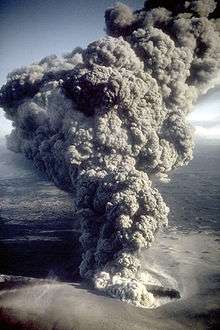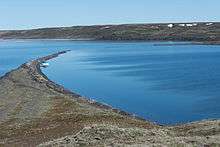Maar



A maar is a broad, low-relief volcanic crater caused by a phreatomagmatic eruption (an explosion which occurs when groundwater comes into contact with hot lava or magma). A maar characteristically fills with water to form a relatively shallow crater lake. The name comes from the local Moselle Franconian dialect of Daun in the Rhineland-Palatinate, Germany, where it derives from Latin mare (sea).[1] Maars are shallow, flat-floored craters that scientists interpret as having formed above diatremes as a result of a violent expansion of magmatic gas or steam; deep erosion of a maar presumably would expose a diatreme. Maars range in size from 60 to 8,000 m (200 to 26,250 ft) across and from 10 to 200 m (33 to 656 ft) deep; most maars commonly fill with water to form natural lakes. Most maars have low rims composed of a mixture of loose fragments of volcanic rocks and rocks torn from the walls of the diatreme.
Examples
The largest known maars are found on the Seward Peninsula in northwest Alaska. These maars range in size from 4,000 to 8,000 m (13,123 to 26,247 ft) in diameter and a depth up to 300 m (984 ft). These eruptions occurred in a period of about 100,000 years, with the youngest (the Devil Mountain Maar) occurring about 17,500 years ago. Their large size is due to the explosive reaction that occurs when magma comes into contact with permafrost. Hydromagmatic eruptions are increasingly explosive when the ratio of water to magma is low. Since permafrost melts slowly, it provides a steady source of water to the eruption while keeping the water to magma ratio low. This produces the prolonged, explosive eruptions that created these large maars. Examples of the Seward Peninsula maars include North Killeak Maar, South Killeak Maar, Devil Mountain Maar and Whitefish Maar.[2]
Maars occur in western North America, Patagonia in South America, the Eifel region of Germany (where they were originally described), and in other geologically young volcanic regions of Earth. Elsewhere in Europe, La Vestide du Pal in the Ardèche department of France provides a spectacular example of a maar easily visible from the ground or air. Kilbourne Hole and Hunt's Hole, near El Paso, Texas, are maars. The Crocodile Lake in Los Baños in the Philippines was originally thought of as a volcanic crater is also a maar. The notorious, carbon dioxide-saturated Lake Nyos in Africa is another example. An excellent example of a maar is Zuni Salt Lake in New Mexico, a shallow saline lake that occupies a flat-floored crater about 6,500 ft (2,000 m) across and 400 ft (120 m) deep. Its low rim is composed of loose pieces of basaltic lava and wall rocks (sandstone, shale, limestone) of the underlying diatreme, as well as random chunks of ancient crystalline rocks blasted upward from great depths. Maars in Canada are found in the Wells Gray-Clearwater volcanic field of east-central British Columbia and in kimberlite fields throughout Canada. A notable field of maars is found in the Pali-Aike Volcanic Field in Patagonia, South America.[3] The Auckland volcanic field in the urban area of Auckland, New Zealand has several maars, including the readily accessible Lake Pupuke in the North Shore suburb of Takapuna.
One of the most notable craters misidentified as a maar is Arizona's Meteor Crater; for many years this was thought to be of volcanic rather than meteoric origin.[4]
Gallery
-

Weinfelder Maar, one of the three maars originally described
-
The maar at Birkat Ram, the Golan Heights
-
Zengena Lake, a maar in Amhara Region, Ethiopia
Notes
- ↑ Notes:
- According to German Wikipedia's "Maar" article, in 1544 in his book Cosmographia, Sebastian Münster (1488–1552) first applied the word "maar" (as Marh) to the Ulmener Maar and the Laacher See. See: Sebastian Münster, Cosmographia (Basel, Switzerland: Heinrich Petri, 1544), p. 341. From p. 341: "Item zwen namhafftiger seen seind in der Eyfel / einer bey de schloß Ulmen / und ein ander bey dem Closter züm Laich / die seind sere tieff / habe kein ynflüß aber vil außflüß / die nennet man Marh unnd seind fischreich." (Also two noteworthy lakes are in the Eifel, one by the Ulmen castle, and another by the monastery at Laich ; they are very deep ; [they] have no streams flowing in but many flowing out ; one calls them "maars" and [they] are rich in fish.)
- In 1819, Johann Steininger (1794-1874), a secondary school teacher from Trier, coined the term "maar" in its modern sense. See: Steininger, J., Geognostische Studien am Mittelrhein [Geological studies on the middle Rhein] (Mainz, (Germany): Kupferberg, 1819).
- In 1825, George Julius Poulett Scrope (1797–1876) introduced the term "maar" into English. See: Scrope, G.P., Considerations on Volcanoes (London, England: Philipps, 1825), p. 166.
- Prof. Horst Noll, a geologist at the University of Köln (Cologne), Germany, said that the local term maar might even have been derived from the Latin word mare (i.e. sea) and been introduced into local language during Roman occupation of the West Eifel. See: Noll, H. (1967) "Maare und Maar-ähnliche Explosionskrater in Island. Ein Vergleich mit dem Maar-Vulkanismus der Eifel" (Maars and maar-like explosion craters in Iceland. A comparison with the maar-volcanism of the Eifel.), Special publication of the Geological Institute of the University of Köln, p. 1.
- Wilhelm Meyer, Geologie der Eifel [Geology of the Eifel] (Stuttgart, Germany: Schweizerbart'sche Verlagsbuchhandlung, 1986), p. 311.
- Herbert Lutz and Volker Lorenz (2013) "Early volcanological research in the Vulkaneifel, Germany, the classic region of maar–diatreme volcanoes: the years 1774–1865." On-line publication of Springer International Publishing, Berlin, Germany.
- The American Heritage Dictionary states that the word "maar" derives from the Latin mare (sea), as does the German language Universal Lexikon.
- ↑ Begét, James E.; Hopkins, David M.; Charron, Steven D. (March 1996), "The Largest Known Maars on Earth, Seward Peninsula, Northwest Alaska" (PDF), Arctic 49 (1): 62–69, doi:10.14430/arctic1184
- ↑ C. Michael Hogan (2008) Pali Aike, The Megalithic Portal, ed. A. Burnham
- ↑ The Science: What is the Barringer Meteorite Crater?
References
External links
| Wikimedia Commons has media related to Maars. |
| |||||||||||||||||||||
